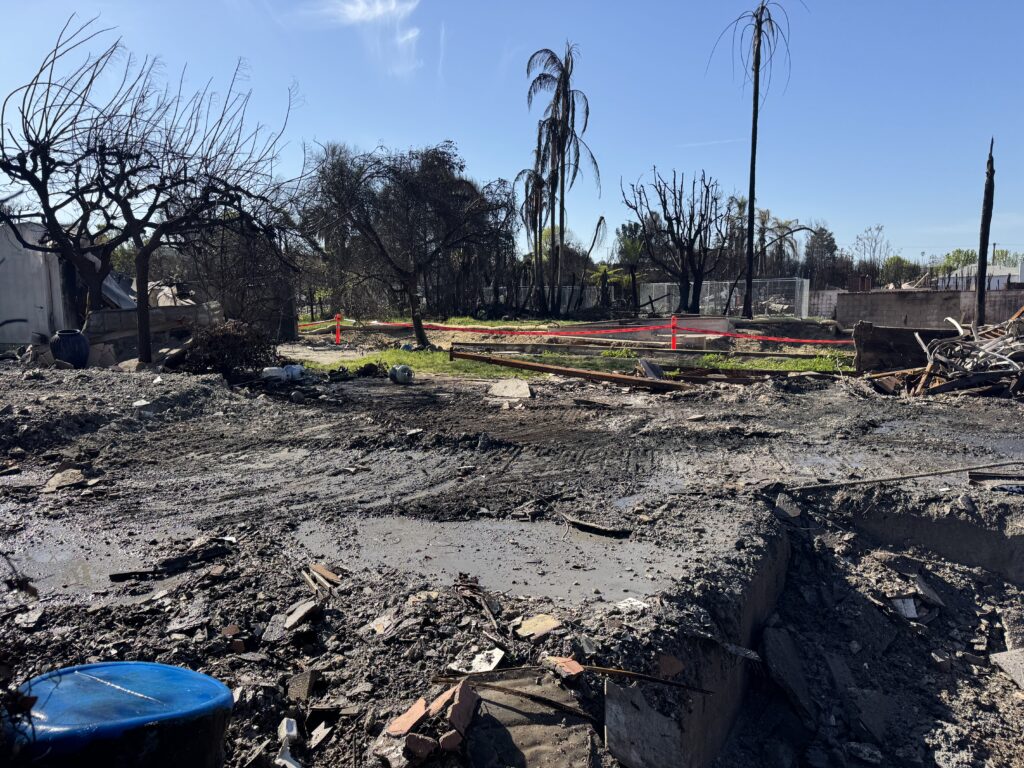Although the Palisades and Eaton fires destroyed nearly 12,000 structures, a large number of homes were left standing in the middle of the debris/burn field. In some cases, that building was the sole house left on a block>
Between the smoke, ash and debris, the question many are asking are the homes safe to move back into?
The Eaton Fire Residents United (EFRU) held a press conference on November 7 in Altadena to say, “no.” Representatives went further and said that of the 50 remediated homes that had been tested in that area, six out of every 10 still had unacceptable levels of lead and/or asbestos.
Jane Lawton Potelle, the founder of EFRU, said that the majority of homes were not safe to return to and the group’s message was simple “Clearance before Occupancy.”
Many spoke about the obstacles encountered with insurance companies, who did not want to pay for testing, or comprehensive remediation. Insurance carriers had been informing people they were no longer paying for Additional Living Expense (ALE), which left some with no choice, but to move back into a home that may not have been properly remediated.
Dawn Fanning, a 30 year Altadena resident, said she spent months looking for a licensed remediator. “Remediation is the wild west right now,” she said noting that only 20 percent of the companies she spoke to are licensed to remediate asbestos and only 60 percent are licensed to remediate lead.
It also appears that many companies have raised their rates after the fires. One person claimed there is price gouging, which is illegal in California. (CTN cannot prove or disprove that statement, but it seems like that’s a claim that could go to the California Governor’s Office of Emergency.)
If prices have been jacked up double and triple as some experts have said, it would mean that the insurance coverage might not cover the cost that EFRU estimates it takes to remediate. Prices range from $35,000 to $100,000 (and that’s before replacement items are purchased, such as furniture or applicances).
CTN spoke to American Environmental Specialist James McGlung, Jr. about what the steps to remediation might look like.
Testing first for lead or asbestos in a standing home, should be done by an independent consultant licensed by the State of California.
If those materials are present, then walls and ceilings can be vacuumed with a super-HEPA vacuum and then wiped down with a super wipe. Then, the space should be retested. McGlung said int might not be necessary to replace walls or insulation.
CTN reached out to Lahaina, Maui realtor Jesse Wald (https://www.youtube.com/@JesseGWald) about remediation in Hawaii after the fires. He responded “Yes, there were definitely concerns about toxins after the fire. My home survived the fire, but it was in the middle of the burn zone and surrounded by ash and debris. Our insurance provider hired Servepro to do a thorough cleaning and smoke remediation. We also replaced all of our insulation as a precaution.”
According to McGlung, if a property tests positive for lead/asbestos all paper, cloth and furniture will have to be thrown out.
Hardwood, such as floors or hard wood furniture can be wiped down. If one has heirlooms, personal items or books, “So Coast Air Quality requires it to be tossed,” McGlung said, “unless a person signs a waiver.”
He said that something like a glass Christmas ornament could be put under water, washing off the dust and then dried and kept.
If a home was remediated and then retested and the lead/asbestos is found, McGlung said, it might have come in with the winds, through windows.
After the property has been cleaned, McGlung said that blue duct tape can be put around the inside windows to seal them and stop tiny particles from blowing in. As more and more homes are built. that means less dust will be blowing into homes from vacant lots.
A resident, who has undergone remediating said, “Just like the insurers are low-balling reconstruction prices, they have low-balled/underpaid those homeowners who only need remediation.”
Like some, this Palisades resident wonders if the money that insurance pays, results in some not getting a licensed contractor they need.
“It makes sense that both sides of the coin (smoke damage vs. burn down) is coming up short in terms of insurance coverage/reimbursement,” the resident said.
“There’s lots of hype,” McGlung acknowledged but said “there are ways to work with this in a calm and rational basis.”



Just think, if we had only demanded the State of CA to perform proper brush clearance of the Santa Monica Mountains, Put back the fire breaks that used to be there from the 1970s, keep both reservoirs is filled with water and pay our firefighters, We wouldn’t even have to be having this conversation about remediation….. but yet,? we just kept voting for the same fools